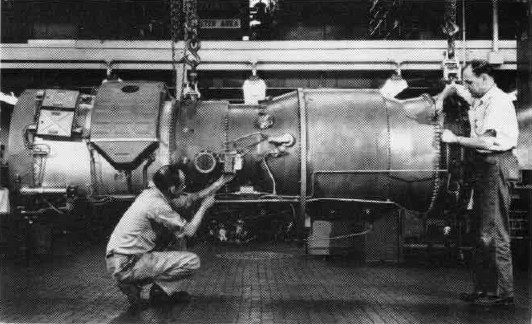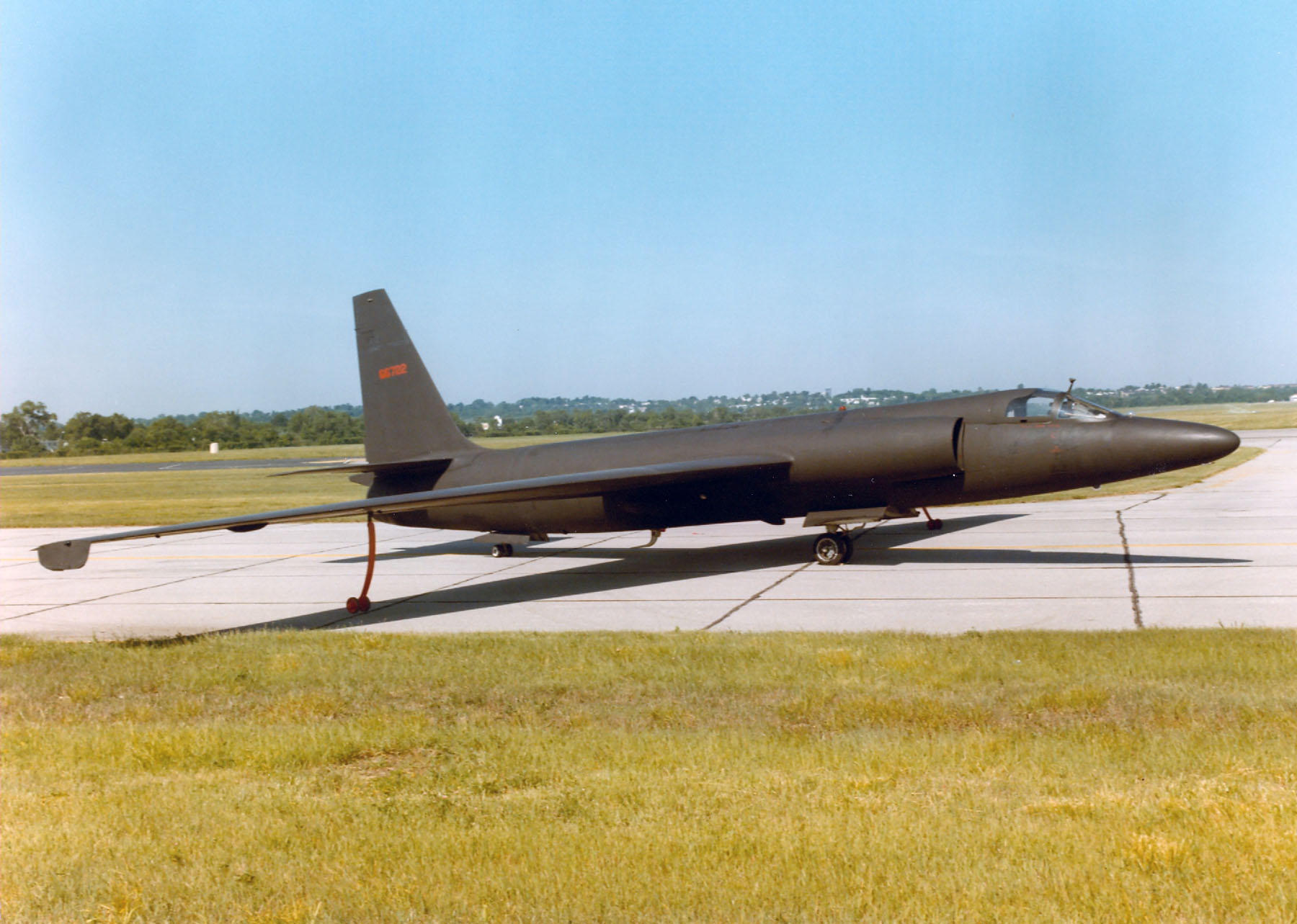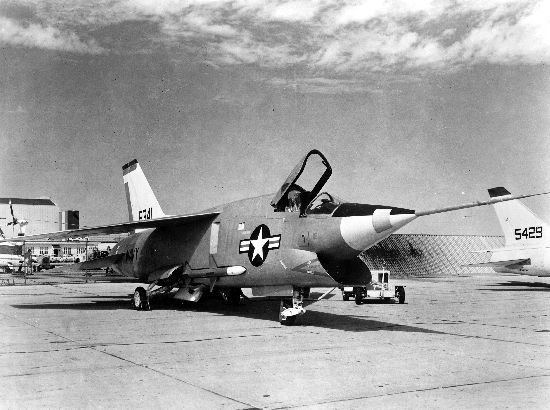|
J75
The Pratt & Whitney J75 (civilian designation: JT4A) is an axial-flow turbojet engine first flown in 1955. A two-spool design in the 17,000 lbf (76 kN) thrust class, the J75 was essentially the bigger brother of the Pratt & Whitney J57 (JT3C). It was known in civilian service as the JT4A, and in a variety of stationary roles as the GG4 and FT4. Design and development In military use, the J75 was used on the Convair F-106 Delta Dart, Lockheed U-2, and Republic F-105 Thunderchief. It was also utilized in the prototype and experimental Avro Canada CF-105 Arrow, Lockheed A-12, Martin P6M SeaMaster, North American YF-107, and Vought XF8U-3 Crusader III. Before the arrival of the Pratt & Whitney JT3D turbofan engine, the JT4A was used to power certain Boeing 707 and Douglas DC-8 models, bringing improved field performance in the medium-range Boeing 707-220 and Douglas DC-8-20, and intercontinental range in the Boeing 707-320 and the Douglas DC-8-30. By late 1959, ... [...More Info...] [...Related Items...] OR: [Wikipedia] [Google] [Baidu] |
Avro Canada CF-105 Arrow
The Avro Canada CF-105 Arrow was a delta-winged interceptor aircraft designed and built by Avro Canada. The CF-105 held the promise of Mach 2 speeds at altitudes exceeding and was intended to serve as the Royal Canadian Air Force's (RCAF) primary interceptor into the 1960s and beyond. The Arrow was the culmination of a series of design studies begun in 1953 that examined improved versions of the Avro Canada CF-100 Canuck. After considerable study, the RCAF selected a dramatically more powerful design, and serious development began in March 1955. The aircraft was intended to be built directly from the production line, skipping the traditional hand-built prototype phase. The first Arrow Mk. 1, RL-201, was rolled out to the public on 4 October 1957, the same day as the launch of Sputnik I. Flight testing began with RL-201 on 25 March 1958, and the design quickly demonstrated excellent handling and overall performance, reaching Mach 1.9 in level flight. Powered by the Pratt & ... [...More Info...] [...Related Items...] OR: [Wikipedia] [Google] [Baidu] |
Lockheed U-2
The Lockheed U-2, nicknamed "''Dragon Lady''", is an American single-jet engine, high altitude reconnaissance aircraft operated by the United States Air Force (USAF) and previously flown by the Central Intelligence Agency (CIA). It provides day and night, high-altitude (), all-weather intelligence gathering. Lockheed Corporation originally proposed it in 1953, it was approved in 1954, and its first test flight was in 1955. It was flown during the Cold War over the Soviet Union, China, Vietnam War, Vietnam, and Cuba. In 1960, Francis Gary Powers, Gary Powers was 1960 U-2 incident, shot down in a CIA U-2C over the Soviet Union by a surface-to-air missile (SAM). Major Rudolf Anderson, Rudolf Anderson Jr. was shot down in a U-2 during the Cuban Missile Crisis in 1962. U-2s have taken part in post-Cold War conflicts in War in Afghanistan (2001–2021), Afghanistan and Operation Iraqi Freedom, Iraq, and supported several multinational NATO operations. The U-2 has also been used for ... [...More Info...] [...Related Items...] OR: [Wikipedia] [Google] [Baidu] |
Pratt & Whitney J57
The Pratt & Whitney J57 (company designation: JT3C) is an axial-flow turbojet engine developed by Pratt & Whitney in the early 1950s. The J57 (first run January 1950) was the first 10,000 lbf (45 kN) thrust class engine in the United States. The J57/JT3C was developed into the J52 turbojet, the J75/JT4A turbojet, the JT3D/TF33 turbofan, and the XT57 turboprop (of which only one was built). The J57 and JT3C saw extensive use on fighter jets, jetliners, and bombers for many decades. Design and development The J57 was a development of the Pratt & Whitney XT45 (PT4) turboprop engine that was originally intended for the Boeing XB-52. As the B-52 power requirements grew, the design evolved into a turbojet, the JT3. Pratt & Whitney designed the J57 to have a relatively high overall pressure ratio to help improve both Thrust-specific fuel consumption and specific thrust, but it was known that throttling a single high pressure ratio compressor would cause stability problems. ... [...More Info...] [...Related Items...] OR: [Wikipedia] [Google] [Baidu] |
Republic F-105 Thunderchief
The Republic F-105 Thunderchief is an American supersonic fighter-bomber that served with the United States Air Force from 1958 to 1984. Capable of Mach 2, it conducted the majority of strike bombing missions during the early years of the Vietnam War; it was the only American aircraft to have been removed from combat due to high loss rates. It was originally designed as a single-seat, nuclear- attack aircraft; a two-seat Wild Weasel version was later developed for the specialized Suppression of Enemy Air Defenses (SEAD) role against surface-to-air missile sites. The F-105 was commonly known as the "Thud" by its crews. As a follow-on to the Mach 1 capable North American F-100 Super Sabre, the F-105 was also armed with missiles and a rotary cannon; however, its design was tailored to high-speed low-altitude penetration carrying a single nuclear weapon internally. First flown in 1955, the Thunderchief entered service in 1958. The single-engine F-105 could deliver a bomb load gre ... [...More Info...] [...Related Items...] OR: [Wikipedia] [Google] [Baidu] |
Vought XF8U-3 Crusader III
The Vought XF8U-3 Crusader III was an aircraft developed by Chance Vought as a successor to the successful Vought F-8 Crusader program and as a competitor to the McDonnell Douglas F-4 Phantom II.Tillman 1990 Though based in spirit on the F8U-1 and F8U-2, and sharing the older aircraft's designation in the old Navy system, the two aircraft shared few parts. Design and development In parallel with the F8U-1s and -2s, the Crusader design team was also working on a larger aircraft with better performance, designated within Vought as the V-401. Although externally similar to the Crusader and sharing with it the variable incidence wing, the Crusader III was larger and was powered by the Pratt & Whitney J75-P-5A engine generating 29,500 lbf (131 kN) of afterburning thrust. The Crusader III was designed for brief excursions to Mach 2.7 and two visible features showed it had a speed capability beyond that of the earlier Crusaders, namely a swept-forward "scoop" air inlet for ... [...More Info...] [...Related Items...] OR: [Wikipedia] [Google] [Baidu] |
Pratt & Whitney GG4
The Pratt & Whitney GG4 and FT4 are related aero-derivative gas turbine A gas turbine, also called a combustion turbine, is a type of continuous flow internal combustion engine. The main parts common to all gas turbine engines form the power-producing part (known as the gas generator or core) and are, in the directio ... engines developed from the Pratt & Whitney J75/JT4 turbojet line.''The History and Future of Technology: Can Technology Save Humanity from Extinction?'' Robert U. Ayres. See also References External links {{DEFAULTSORT:Pratt and Whitney GG4[...More Info...] [...Related Items...] OR: [Wikipedia] [Google] [Baidu] |
Lockheed A-12
The Lockheed A-12 is a high-altitude, Mach 3+ reconnaissance aircraft built for the United States Central Intelligence Agency (CIA) by Lockheed's Skunk Works, based on the designs of Clarence "Kelly" Johnson. The aircraft was designated A-12, the 12th in a series of internal design efforts for "Archangel", the aircraft's internal code name. In 1959, it was selected over Convair's FISH and Kingfish designs as the winner of Project GUSTO, and was developed and operated under Project Oxcart. The CIA's representatives initially favored Convair's design for its smaller radar cross-section, but the A-12's specifications were slightly better and its projected cost was much lower. The companies' respective track records proved decisive. Convair's work on the B-58 had been plagued with delays and cost overruns, whereas Lockheed had produced the U-2 on time and under budget. In addition, Lockheed had experience running a "black" project. The A-12 was produced from 1962 to 19 ... [...More Info...] [...Related Items...] OR: [Wikipedia] [Google] [Baidu] |
Pratt & Whitney JT3D
The Pratt & Whitney JT3D is an early turbofan aircraft engine derived from the Pratt & Whitney J57, Pratt & Whitney JT3C. It was first run in 1958 and was first flown in 1959 under a B-45 Tornado test aircraft. Over 8,000 JT3Ds were produced between 1959 and 1985. Most JT3D engines still in service today are used on military aircraft, where the engine is referred to by its US military designation of TF33. Design and development Aware of the competition from the Rolls-Royce Conway turbofan, Pratt & Whitney decided to develop the JT3D turbofan from the JT3C turbojet for later deliveries of the Boeing 707 and the Douglas DC-8, then nearing entry into service. A 2-stage fan replaced the first 3 stages of the 9-stage JT3C LP compressor. On the LP turbine, the second stage was enlarged and a third stage added. Unlike GE with the CJ805-23, Pratt & Whitney had not undertaken any transonic fan research prior to designing the JT3D, so they were unable to incorporate a single stage unit in ... [...More Info...] [...Related Items...] OR: [Wikipedia] [Google] [Baidu] |
Pratt & Whitney
Pratt & Whitney is an American aerospace manufacturer with global service operations. It is a subsidiary of Raytheon Technologies. Pratt & Whitney's aircraft engines are widely used in both civil aviation (especially airlines) and military aviation. Its headquarters are in East Hartford, Connecticut.Contact Us ." Pratt & Whitney. Retrieved on January 7, 2011. "Corporate Headquarters Pratt & Whitney 400 Main Street East Hartford, CT 06108." As one of the "big three" aero-engine manufacturers, it competes with and , although it has also formed joint ventures with both ... [...More Info...] [...Related Items...] OR: [Wikipedia] [Google] [Baidu] |
Martin P6M SeaMaster
The Martin P6M SeaMaster, built by the Glenn L. Martin Company, was a 1950s strategic bomber flying boat for the United States Navy that almost entered service; production aircraft were built and Navy crews were undergoing operational training, with service entry expected in about six months, when the program was cancelled on 21 August 1959. Envisioned as a strategic nuclear weapon delivery system for the Navy, the SeaMaster was eclipsed by the Polaris submarine-launched ballistic missile (SLBM). Due to the political situation at the Pentagon, the Navy promoted the P6M primarily as a high speed minelayer. Design and development In the immediate postwar defense climate, the United States Air Force's Strategic Air Command was the linchpin of the United States' security as the sole means of delivery of the nation's nuclear arsenal. The Navy saw its strategic role being eclipsed by the Air Force and knew both its prestige and budgets were at stake. Its first attempt to address ... [...More Info...] [...Related Items...] OR: [Wikipedia] [Google] [Baidu] |
Convair F-106 Delta Dart
The Convair F-106 Delta Dart was the primary all-weather interceptor aircraft of the United States Air Force from the 1960s through to the 1980s. Designed as the so-called "Ultimate Interceptor", it proved to be the last specialist interceptor in U.S. Air Force service to date. It was gradually retired during the 1980s, with the QF-106 drone conversions of the aircraft being used until 1998 under the ''Pacer Six'' program.Winchester 2006, p. 55. Development Antecedents The F-106 was the ultimate development of the USAF's 1954 interceptor program of the early 1950s. The initial winner of this competition had been the F-102 Delta Dagger, but early versions of this aircraft had demonstrated extremely poor performance, limited to subsonic speeds and relatively low altitudes. During the testing program the F-102 underwent numerous changes to improve its performance, notably the application of the area rule to the fuselage shaping and a change of engine, and the dropping of the advan ... [...More Info...] [...Related Items...] OR: [Wikipedia] [Google] [Baidu] |
North American YF-107
The North American F-107 is North American Aviation's entry in a United States Air Force tactical fighter-bomber design competition of the 1950s. The F-107 was based on the F-100 Super Sabre, but included many innovations and radical design features, notably the over-fuselage air intakes. The competition was eventually won by the Republic F-105 Thunderchief, and most of the F-107 prototypes ended their lives as test aircraft. One is on display at the National Museum of the United States Air Force and a second at Pima Air and Space Museum. Design and development In June 1953, North American initiated an in-house study of advanced F-100 designs, leading to proposed interceptor (NAA 211: F-100BI denoting "interceptor") and fighter-bomber (NAA 212: F-100B) variants. Concentrating on the F-100B, the preliminary engineering and design work focused on a tactical fighter-bomber configuration, featuring a recessed weapons bay under the fuselage and provision for six hardpoints und ... [...More Info...] [...Related Items...] OR: [Wikipedia] [Google] [Baidu] |








